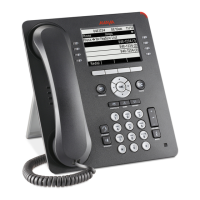Other network considerations
Issue 1 May 2011 37
After a successful registration, the following system values are set:
REUSE_IPADD will be set to the value of IPADD,
REUSE_NETMASK will be set to the value of NETMASK,
REUSE_ROUTERS will be set to the value of ROUTER,
REUSE_ROUTER_IN_USE will be set to the value of ROUTER_IN_USE,
REUSE_TAGGING will be set to the value of TAGGING,
L2QVLAN_INIT will be set to the value of VLAN_IN_USE,
the MIB object endptVLANLIST will be set to the value of VLANLIST and then the value of
VLANLIST will be set to null.
QoS
For more information about the extent to which your network can support any or all of the QoS
initiatives, see your LAN equipment documentation. See Administering QoS
on page 50 for
QoS implications for the 9600 Series SIP IP Deskphones.
All 9600 Series SIP IP Telephones provide some detail about network audio quality. For more
information see, Displaying network audio quality
on page 38.
IEEE 802.1D and 802.1Q
For more information about IEEE 802.1D and IEEE 802.1Q and the 9600 Series SIP IP
Telephones, see Administering IEEE 802.1D and 802.1Q
on page 50 and Administering a
VLAN on page 113. Three bits of the 802.1Q tag are reserved for identifying packet priority to
allow any one of eight priorities to be assigned to a specific packet.
●
7: Network management traffic
●
6: Voice traffic with less than 10ms latency and jitter
●
5: Video traffic with less than 100ms latency and jitter
●
4: “Controlled-load” traffic for critical data applications
●
3: Traffic meriting “extra-effort” by the network for prompt delivery, for example, executive
e-mail
●
2: Reserved for future use
●
0: The default priority for traffic meriting the “best-effort” for prompt delivery of the network
●
1: Background traffic such as bulk data transfers and backups
Note:
Note:
Priority 0 is a higher priority than Priority 1.

